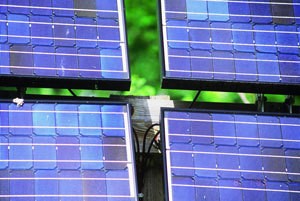
When it comes to solar power, most people are interested in it, but they have no idea how to get started. For those that decide to forge ahead and explore their options, many become intimidated by the all of the confusing terminology or abandon their solar aspirations early fearing a hefty price tag. Getting started in solar isn't as hard (or as costly) as you might think, provided that is, that you start with the basics.
Before you sink $10,000-$12,000 dollars into a full-blown solar powered system, have an energy audit done on your house. Solar panels won't change how your house uses energy, it will only change how the electricity your house uses is generated. If heat still escapes out the windows, walls and attic, or you're still operating energy-hogging appliances, $10,000-$12,000 in energy efficiency upgrades will do far more to help the environment (and lower your energy bills) than solar panels.
My husband and I are in the planning stages of building our "Green Dream House" and recently attended a Green Building Conference to gather some information. Our workshop presenter posed this question, "Why do you want to go solar?" Many of us answered that it was good for the environment, others said they wanted to eliminate their dependence on local utilities and still others hoped to sell their excess power back to the utility companies for a profit (although these people soon realized this was not a realistic goal).
Obviously, solar panels need sun to generate electricity efficiently and economically. The amount of electricity you will be able to generate at your site depends on how much of the sun's energy reaches it. Ideally, locations in the northern hemisphere should be orientated to true south. However, panels can usually face up to 45º east or west of true south and still perform sufficiently. You may be able to use either roof-mounted panels or free-standing systems for the ground that are either fixed in one position or designed to "track" the sun.
If you determine that installing a solar system isn't right for you because of your site, but you still want to participate in using renewable energy, consider offsetting your current power use by investing in renewable energy certificates (green power) through your local utility. To find out what is available in your area visit the EPA's Green Power Partnership page at http://www.epa.gov/grnpower/locator/index.htm
Whether you're investing in solar energy to generate all of your home's power or just to heat the water, you will need to assess how much power you currently use before you know what size system you'll need. To do this you need to evaluate your energy consumption patterns and determine whether or not you can find ways to reduce the amount of electricity you use. Look at your monthly utility bills over the course of a year. Make note of when you use the most energy and how many kilowatts you consume in an "average" month. Solar panels are designed to produce a specific number of kilowatts of electricity each hour of full sun ( e.g. a 100 kW system would produce 100 kW of electricity in full sun for one hour).
Once you determine the number of kilowatts you need you will be able to determine how much a system that can handle the load will cost. The up-front purchase price of solar power systems can vary depending on whether you install if yourself, your geographic location and whether or not you buy new or used panels. There are many rebates, subsidies and tax incentives available that, depending on the system, can defray the cost of installation by as much 50%. These usually come in the form of tax rebates, property tax exemptions or sales tax exemptions and are sometimes capped at a certain dollar amount.

About The Author: Ellen Brown is an environmental writer and photographer and the owner of Sustainable Media, an environmental media company that specializes in helping businesses and organizations promote eco-friendly products and services. Contact her on the web at http://www.sustainable-media.com
Add your voice! Click below to comment. ThriftyFun is powered by your wisdom!
There are some good instructions here to help you get started:- www.yourgreendream.com/
Add your voice! Click below to comment. ThriftyFun is powered by your wisdom!